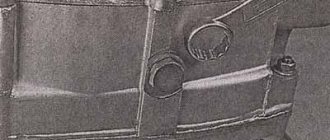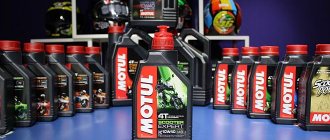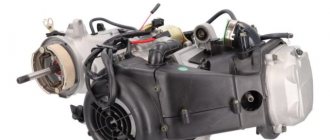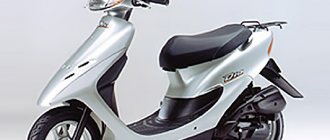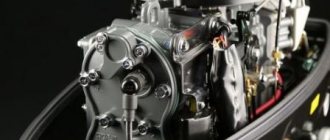The popularity of ATVs has determined the width of their model range - from simple models with minimal equipment to powerful multi-axle options for purely utilitarian purposes. A separate article is sports ATVs, which are distinguished not only by highly accelerated engines with an extremely lightweight design, but also by the use of manual transmissions instead of the usual CVT. This technique can be an excellent way to get adrenaline and help a hunter or farmer.
A competent choice of oil for an ATV engine will allow you to achieve maximum service life from it. This is especially important during severe operation - transporting heavy loads, fording, etc. Even on a prepared ATV with snorkels installed, there is a high risk of water getting into the crankcase, which means that the protective properties of the oil must be at a high level. In any case, if an emulsion is detected on the dipstick or in the oil tank (on ATVs with a dry sump), the oil must be changed immediately. They will require inspection and a gearbox.
For most models of four-wheeled vehicles, ROLF Lubricants GmbH can offer decent quality and attractively priced oils with reliable protection against counterfeiting.
What kind of oil to pour into an ATV engine
ATV engine oil must first match the type of engine. The vast majority of existing models are equipped with one- or two-cylinder water-cooled gasoline engines, that is, they require API S oils. A small number of ATVs produced in the simplest configuration continue to use 2T engines - they are simpler, cheaper and lighter. In this case, only special two-stroke oils of API TC quality class can be used.
Heavy utilitarian ATVs, including those of the Side-by-side class, are also equipped with diesel engines. For them, it is worth choosing a specialized oil for diesel engines (API class group C), but it is also possible to fill with universal motor oils, since their characteristics are suitable for diesel engines used on utilitarian ATVs.
The frequency of oil changes is determined by the manufacturer and is given in the service book. It is recommended to change the oil at the beginning of the season if the ATV is not used in winter, even if it has only had low mileage in the previous year.
Antifreeze for ATV
As you can see, antifreezes differ in color, but it is important to remember that the color of antifreeze does not affect the technical characteristics. At the same time, it should be taken into account that the “acid” color of antifreeze only indicates that the composition contains a fluorescent additive, which plays an important role in diagnosing the cooling system - places of coolant leakage are identified (glow) when the engine compartment is illuminated with ultraviolet light.
Expert advice: Therefore, when choosing antifreeze, you cannot be guided by the “color to color” rule. Coolants of the same color can have completely different compositions, which can lead to damage to the ATV.
CFMOTO recommends using antifreeze based on ethylene glycol and hybrid technology additives - G-Energy Antifreeze NF 40 - for engine cooling.
Is it possible to put car oils into an ATV?
Since most ATVs are equipped with a CVT transmission and do not have a clutch in an oil bath, they do not have an urgent need to use 4T motor oils. The fundamental difference between motor oils for four-stroke engines and conventional automobile ones is precisely the presence of friction modifiers and the normalization of antifriction properties, which is necessary to ensure normal clutch operation.
Therefore, the use of ROLF automobile motor oils on such ATVs is more than justified. For example, the operating instructions for BRP Outlander ATVs directly indicate that the original engine oil can be replaced by any SAE 5W-40 automobile oil with a quality class of at least API SG. Given such low requirements, any ROLF 5W-40 oil will work perfectly in this technique.
You can do the same when buying a diesel ATV. For example, for Polaris Ranger Diesel, the instructions require the use of original Polaris Diesel Oil (SAE 15W-40) engine oil or diesel oils that match the viscosity.
There are only two cases where you can’t pour car oil into an ATV engine. First of all, we are talking about sports models equipped with a “wet” clutch and a manual gearbox in a common lubrication circuit with the engine. They need specialized synthetic oils for four-stroke engines designed specifically for such operating conditions.
ATVs with two-stroke engines also require their own type of lubrication. Of the entire range of two-stroke oils, the optimal ones are those that are designed for motorcycles, taking into account their inherent operating temperatures and loads.
Benefits of oils
The main advantage of CFMOTO G-Motion 4T 5W-40 for the consumer is the ability to use the product in a wide range of operating temperatures: for example, the oil provides cold engine starting down to -30 0 C.
In turn, CFMOTO G-Motion 4T 10W-40 provides increased engine protection under very high loads by maintaining a stable oil film.
There are other features of these particular oils, showing that they have high performance characteristics, which have been repeatedly confirmed by testing oils in real conditions (see Presentation of test results).
Engine oil for ATVs ROLF MOTO 2T
This oil is designed as a universal oil for motorcycles with medium and large cylinder displacements. It is compatible with all types of lubrication systems, can work in a gasoline-oil mixture, in separate lubrication of carburetor engines and on two-stroke engines with electronic fuel injection.
Engine oil for ATVs ROLF MOTO 2T
ROLF Moto 2T oil meets the stringent current requirements for two-stroke oils for protection against wear, smoke, and carbon formation. It preserves the functionality of the spark plug for a long time, preventing contamination of the electrodes with unburned oil residues. Thanks to anti-wear additives, the engine remains protected from scuffing on the piston and cylinder walls at high temperatures.
Varieties
The base used to make the oil ensures that the required characteristics of the liquid are obtained. Lukoil Lux synthetic oil is produced from organic compounds, consists of identical molecules, is chemically stable and resistant to temperature influences. The main disadvantage is the high cost, which is why it is usually used in new engines.
Mineral oil for ATVs is significantly cheaper and is made from petroleum products. Despite the fact that in some respects it is somewhat inferior to its synthetic counterpart, the composition ensures the full functioning of the power device. It will be the best option when used in climatic conditions with a minimum temperature level of -15 degrees for the operation of a motor with sufficient mileage.
Lukoil Lux polysynthetic oil contains a mineral and synthetic base. It combines the characteristics of the two types of oils mentioned above and is recommended for use in modern engines with high mileage.
Specifications
| Density at 15 °C, kg/m3 | 876,8 |
| Kinematic viscosity at 100 °C, mm2/s | 10,76 |
| Kinematic viscosity at 40 °C, mm2/s | 81,36 |
| Viscosity index | 118 |
| Flash point in an open crucible, °C | 158 |
| Pour point, °C | -42 |
| Quality classes | JASO FD/ISO-L-EGD, JASO FB/API TC |
| Tolerances | Rotax 253, Piaggio Hexagon |
Standards and Specifications
For four-stroke engines of ATVs with CVT transmissions, the same standardization systems are relevant as for cars. That is, the main quality classification is the commonly used API standard, and due to the less stringent environmental requirements for ATVs, outdated classes like API SJ are still used.
The viscosity of oils is also marked according to the SAE standard used for automobile oils. Since ATVs are often used not only in summer, but also in the off-season, and sometimes in winter, the optimal choice for them is all-season oils, which is confirmed by the above excerpts from the requirements of the instructions.
For ATVs with a wet clutch, the engine oil must also meet the JASO MA2 quality class. It takes into account the specific requirements of such engines for the antifriction properties of oils. In the ROLF product line, ROLF GT 5W-40 SN/CF has this approval.
Two-stroke oils are standardized according to a separate group of API classes, of which API TC is currently relevant. But it is optimal to choose an oil produced taking into account additional JASO/ISO specifications with a group of at least C (that is, JASO FC, ISO-L-EGC). Compared to API TC oils, they protect the engine better, smoke less during combustion, and form less soot.
Approximate cost of oils from different manufacturers
Products from the following manufacturers are found on the Russian market:
- Liqui Moly. NS synthetics for a four-stroke engine costs 750-800 rubles per 1 liter (5W50) or 2300-2500 per 4 liters.
- Yamalube. For two-stroke engines 1 liter - 1000 rubles. For four-stroke engines: synthetic 10W40 – 1300 rubles per 1 liter, mineral 10W40 – 600.
- Motul. Synthetics for four-stroke engines cost about 1200 per 1 liter (5W40) or 4600-4700 rubles per 4 liters. For two-stroke engines - 600-800 rubles per 1 liter. For transmission - about 1400-1500 rubles per 1 liter (75W90). Mineral for four-stroke - costs about 600-700 per 1 liter (10W40) or 2200-2400 per 4 liters.
- Castrol. Engine 5W30 costs about 2300 rubles per 4 liters or 650-750 per 1 liter. For transmission - 75W90 costs 900 rubles per 1 liter, 80W90 - 400-450.
- Repsol. For four-stroke engines, 10W40 synthetic costs about 1000 rubles per 1 liter.
- Total. Synthetics cost about 500-600 rubles per 1 liter of 5W30 or 1400 per 4 liters.
- Shell. Synthetics for four-stroke engines cost about 2000-2100 rubles per 4 liters (5W40) and 650-700 per 1 liter.
Motul has the largest selection of oils. But Motul products are about 20-40% more expensive than average due to the popularity of the brand. Since the oil has to be changed frequently, it is not necessary to buy one.
And for completeness, original oil filters cost about 350-600 rubles. But instead of them you can install cheaper analogues for 200-400 rubles.
Transmission oils for gearboxes
Since on ATVs the gearbox either does not require lubrication at all (dry variator), or the manual transmission is lubricated directly with engine oil, only the gearboxes require their own lubrication.
The selection of oil for replacement should be based on the properties of the original lubricant and the instructions in the operating instructions. Thus, gearboxes with a mechanical differential lock (including an external solenoid) can most often operate on conventional ROLF gear oils of API GL-4 or GL-5 quality class. For example, for Arctic Cat ATVs on most models, the instructions recommend using oils with a viscosity of SAE 75W-90 and quality class API GL-5. ROLF TRANSMISSION PLUS 75W-90 GL-4/GL-5 meets these requirements. A number of BRP ATVs require the use of a thicker 75W140 GL-5 oil, and there are no analogues for it in the current ROLF line.
Gearboxes with viscous couplings or electromagnetic couplings deserve special attention. The use of conventional transmission oils in them can disrupt the normal operation of the gearbox and even lead to its repair due to clutch failure. In particular, this applies to Polaris front gearboxes, lubricated with special Polaris Demand Drive oil.
What do you need to know?
The instructions indicated on the packaging indicate the approximate timing of oil changes. When purchasing a new ATV, it is worth considering the break-in period, during which it does not require the use of a new compound. On average, filter elements and the oil itself are replaced every 1000 km. Diagnostics and maintenance of other systems are carried out at a similar interval.
Naturally, we should not forget about unscheduled maintenance, which is quite difficult to prevent, because vehicles can either get stuck in the mud or fall into water. After such incidents, it is recommended to disassemble it to remove dirt and moisture. New oil is poured into the ATV gearbox after reassembly and complete drying.
Compliance with the rules will extend the life of the equipment and prevent premature wear of important parts subject to constant loads. In this case, systematic maintenance plays an equally important role.

